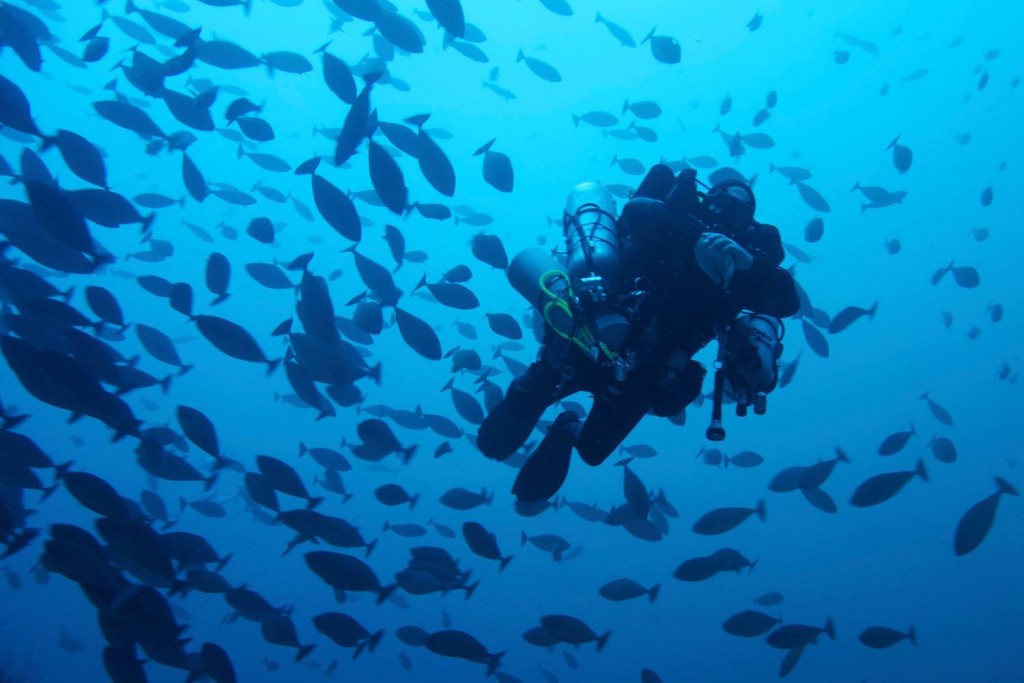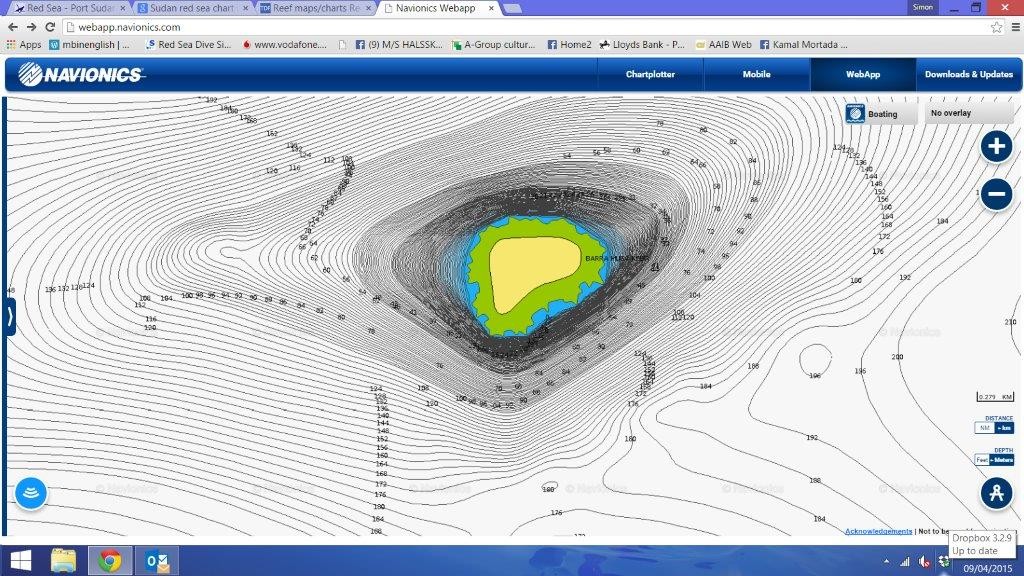Sudan is quite a remote place, not that easy to travel to and is known to most as a war torn region. Our adventure started in Port Sudan where we boarded the Egyptian boat which was to be our home and dive platform.
Diving in Sudan has been possible for many years but technical diving is unknown there. The mystery of the Macalle was no secret but it still remained undiscovered and I believed this was due to the depth. Beyond the reach of normal scuba diving.
We arrived at the Island of Barra Musa Kebir in the southern Sudanese waters of the Red Sea early on Wednesday morning and all of the equipment was prepared and checked out the previous day.
The story of the Macalle was familiar to all on board. I had known about it for around a year and had been planning this expedition for ten months. It had been quite a task as equipment such as rebreather cylinders, carbon dioxide absorbent and stage rigging kits had to be bought in Europe and shipped out to Port Sudan 7 months earlier. The Helium and the gas mixing equipment also had to be sent down on the boat well in advance of the trip. It was nice to be reunited with the equipment after seeing that it all arrived where it should be. Without it the trip would have been impossible. “If you need one then you have to have two”. This philosophy was put to the test when one of the booster pumps had a problem, but we managed to strip it down and fix it. It would have been a big job filling cylinders with only the backup pump.
The contour map that we had of the sea bed around the island had given us some clue of the depths that we would be dealing with and the incline of the wall as the island emerges from the sea. We had also studied the two diaries of the submarines crew members and knew the direction that the Macalle would be traveling and therefore the area of the island that we needed to search.
The first dive on the island for me was from the boat and I was to descend looking for where the wall was to level out into a slope as suggested on the contour map. However it wasn’t to be, the wall continued and the sea was darker than I had ever seen in the Red Sea. I thought that this was because we were in the shadow of the island. I met with Simon N on decent and he stayed above me as I descended to 112 meters and scootered along. As I ascended, Simon descended and we covered the south western side of the island and it was all wall to 112 meters. I was quite surprised at the depth of the wall as it was nothing like the chart suggested. Sheer vertical wall and no sign of any bottom in the inky waters below.
As we emerged from the sea the teams who had dived the other areas were reporting the same, deep vertical wall. Whilst we had been diving the folk on the surface had been attempting to undertake a sonar survey. We had two sonar systems, a sidescan that would provide an image of the sea bed to a depth of 100 meters and a downscan that should read to 180 meters. The chart showed that the maximum depth was 180 meters but the downscan didn’t appear to be working.
The following day teams were deployed to look in different areas. Simon N and I were to take the south west tip, we were dropped by zodiac and descended. The plan was same as the previous day – I was to descend first and heading west and Simon would stay above and as I ascended he would descend and then we would explore the plateau at 60 meters. As I dropped below 100 meters I could see Simon above me heading East, I went down to 130 meters and I could see what seemed like the bottom. I dropped further to explore but the bottom was just a shelf, like a balcony jutting out from the wall. It was very dark down there and nothing like the depths of the Egyptian Red Sea that I was used to. This dive I had torches and they couldn’t pick anything out. I clipped on the scooter and headed East to meet up with Simon.
I had been going along for a few minutes and as I started to ascend, there was a flashing behind me. It was Simon with his torch signalling, asking if I had a problem. I let him know that I was okay and he signalled to turn and follow him. I started to ascend above him to 100 meters and continued west until he returned.
When it came to the search of the plateau, Simon was clearly outpacing my scooter and lost him in the distance. I waited and then began my ascent and the decompression that followed.
We met on the trapeze and the others turned up but nobody had seen anything, just sheer wall.
After two days of no signs or traces we headed back out to scan the areas and see if the sonar could pick anything up. Riccardo said that he done it the old fashioned way and dropped a line and found 195 meters under the boat. 195 meters and we were only 10 meters from the reef.
The following day the plan was to have a day “off gassing” letting the micro bubbles out of the bodies tissues and preparing for the next day’s searching. Other teams were to try the other side of the island. All reported sheer walls and nothing to see apart from one who found some metal bars.
The plan for the following day was to dive to 180 meters and from there we would expect to see the bottom. Scooter along and hope for the best. Now I’m not known for being foolhardy and the plan did seem a little bit so. Simon N had a more powerful scooter than I did and I made the decision to dive only if there was something to see. He would go it alone, power along on the scooter and if he found anything, deploy a lift bag and I would drop down on the line of the bag when he was on the decompression station and this way I would use the same bail out stages for the deep portion of the dive (always assuming that he hadn’t used them). I mixed the gases and prepared.
The following morning Simon N dropped into the water and descended. We waited and nothing. About an hour later a DSMB (delayed surface marker buoy) was deployed and the support team dropped in and removed the stages from him and brought them back to the boat just in case I wanted to go down and have another look. They then started the lengthy process of checking on him while he decompressed.
The support team of Samer and Ronald were used to tending to Simon and they came back and reported that the bottom was 210 meters and no Submarine. I decided to have an easy dive with Ally with a max depth of 120m on the Eastern plateau where lots of sea life had been reported. Just as everyone said, it was very beautiful. We were greeted on arrival by landing in a school of Barracuda, we were followed by a large school of sleek unicorn fish way beyond 100 meters and it was one of the nicest scenic dives that I had ever done.

When back on the boat Simon was on his last decompression stop. The surface O2. He told me that he’d been to 210 meters and the bottom was nowhere in sight. He had scootered along and nothing, just sheer wall. In all the dive was over seven and a half hours. He did mention that the Nappy was placed under my pillow as a memento.
This was to be the final dive on Barra Musa Kebir. The following morning we headed back to Port Sudan stopping for a scenic dive en-route.
The group in total had completed 27 dives below 100 meters in 4 days. All divers used rEvo rebreathers and there were no equipment issues or diver issues. Everyone returned to Port Sudan satisfied that the Macalle is beyond the reach of normal technical divers. However, returning with more powerful sonar equipment and an ROV (remote operated vehicle) is now being talked about, we will see…..
This wasn’t just a deep wreck hunt, it was a week of diving where each and every diver pushed their own personal limits. We were way beyond help if anything went wrong, there is a private chamber in Port Sudan but we elected to plan for in water recompression. Thankfully there wasn’t so much as a headache encountered. This was a testimony to the ability and training of the dive team.
Team members, Simon Taylor-Watson, Simon Nadim, Marco Scaccabarozzi, Stephen Green, Claude Shafter, Blaise Jeanneret, Stephane Peterhans, Alison Mc Dowell, Tony Evans, Steve Harriss, Samer Isa, Ronald Rizk, Giulio Bartelli and Anze Petric.
Learn more about Tekdeep, Tekdeep Safaris and rEvo Rebreathers using the following links.
http://www.tekdeep.com – http://www.tekdeep.com/safaris/ – http://www.revo-rebreathers.co.uk





